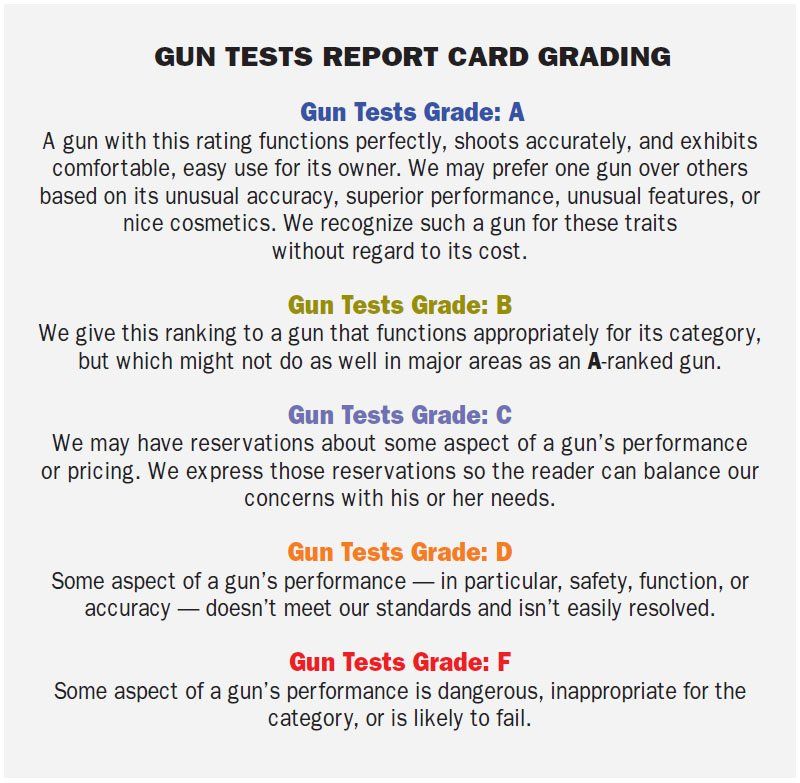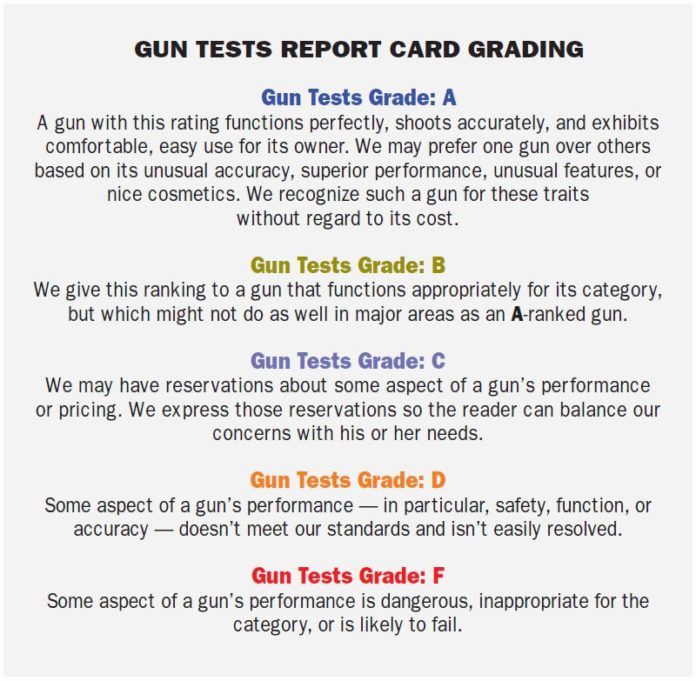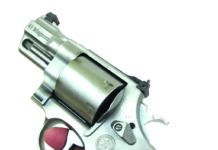Re “Firing Line,” August 2017
Dear Todd: I sincerely hope you don’t change the grading scale to what is effectively pass/fail. Larry brings up an interesting point that would provide one way of comparing future evaluations, although comparing future with present and past scales could be unduly confusing. Personally, I thought the old scale was just fine, though I have adjusted to the new one.
Here’s what I like about the status quo of the rating system:
– The “A” or “A+” rating allows room at the top for superlative craftsmanship.
– Resurrection of the “Best Buy” rating is helpful.
– Comparing ratings between the current scale and the old one is simple enough.
– You seem to have been removing the price from the letter grade recently, and I am a fan of that. While I don’t have a stable full of multi-thousand-dollar fillies, the manufacturers should not be penalized on price alone. We can individually make that decision based on our personal preferences and budgets.
– When the gun is returned to the factory, then you reevaluate for an adjusted rating. I live in a world where I make products for customers every day, and no matter how good you are, someone will eventually be unhappy. How the manufacturer responds to that is very important to me. I appreciate the manufacturers who stand behind their products.
What I would like improved:
– Consistency from rater to rater. As an example, there seem to be some raters who grade more harshly for malfunctions than others. In some cases, a malfunction will get an “F” where others may only be a “C” or “D” instead. (I will admit this is a full-on perception over time that I have not validated by comparing multiple issues.)
– Consistency between brands. Some brands seem to get a free pass where others take a beating. For example, Glocks seldom (if ever) get penalized for disassembly woes, yet I feel like I need three hands for that task. Meanwhile, other brands have been derided because they need a tool as simple as a bent paper clip for disassembly. Likewise, certain triggers are notoriously mushy, yet they rate well next to a crisper one. If those two guns are otherwise equal, the nasty trigger should get downgraded. Finally, I always consider your ratings with a grain of salt. While the rating system is helpful, if I am seriously considering a particular gun, I read the entire evaluation because the test may have been conducted with different criteria than my intended use. Thanks!
— Paul

Hi folks. Thanks so much for the reliable reporting. Regarding the “fail more” idea, I’m not warm to it as a preset inclination. If the industry happens to reach a stage of quality where no new gun meets the criteria for your “F” or “D” grade, I’m happy to see A’s, B’s, and C’s as you judge them. Your grading seems finely-grained/nuanced enough, and functionally described/discriminating already.
I’d strive to own an “A,” keep a “B” if I liked it, sell or upgrade a “C,” and not have anything to do with the rest if possible, unless I can get them for pennies and get them fixed economically. If guns are getting better at the top, maybe have an occasional A+? Thanks again.
— Joe
Dear Gun Tests: Thanks for another great issue this month. In regards to the letter sent in by reader Larry, I would like to answer your question about the grading scale. Keep it! As long as you keep up with the excellent writing, explaining your reasons for giving the assigned grade and what the testers feel, I think it’s an excellent system. Here’s why:
In my view, there are more factors to consider when one wants to label something as complex or not. Yes, an automatic transmission is complex, as most all gear boxes tend to be. But the few parts that are on a 1911 do a lot when the trigger is pulled. The cuts on top of the barrel, the barrel cam pin, feed-ramp angle, magazine-feed lips angle, and quality of metal in the magazine, to name a few items. The most important feature of all (in my opinion), is how the firearm is manufactured and what the manufacturer says is, or is not, a finished piece, goes a long way to determine quality, complexity, or completeness. I, too, have been in quality control for many years, and parts alone are not what makes something complex. Small cuts, holes, and such that are sometimes held to incredibly tight tolerances can make something complex, even though there may only be one or two parts that have this feature from the print or engineers drawing.
And besides, who in their right mind wants something to be complex when simpler is much better? And I have in the past sent a vehicle back for the automatic transmission, and I know of a couple of people who have done the same thing.
Then there’s the discussion of grading something which can be more a matter of taste as opposed to just quality. Judging a firearm is like judging one meal from a national restaurant chain. Firearm Maker A may have the exact same standard as Maker B, but which one sells better, or is judged to be better, is a matter of one’s taste. So 20 people who test those two (imaginary or real firearms) may yield 20 different opinions. So in closing, keep up the good work Gun Tests. Keep the testing, keep giving clear, concise reasons as to the reason for the grade you assign, keep giving us readers the tests on the guns we want to learn about. And this reader will keep a subscription as long as I can! Thanks.
— M.
Larry’s letter made some interesting points. I think the D grade may be eliminated. If you dislike a gun that much, then give it an F. I would like to see you keep the B grade. Sometimes the things you dislike to downgrade a gun from an A are not critical factors for me. I most likely would NOT buy anything you gave a C grade to. My vote is to keep the C grade as long as the gun functions properly. That way, if I see someone else has bought a C gun, I won’t worry about its functioning.
— George
Thumbs up to you guys on the firearms and accessories reviews. Just read the current feedback where reader Larry opines on the grading scale. Tip of the hat to him. I agree. I have read so many reviews over the years wherein firearms in less-than-perfect condition and or operability are given a pass. I immediately stop reading that particular review and eliminate that firearm from any purchase consideration. I consistently train, study the law, and conceal carry as a responsible U.S. citizen. Why would anyone have anything less than “top-shelf” in their inventory? It is either designed and works to accomplish its intended purpose or it doesn’t. Period.
Everyone has an opinion, and if you don’t change a thing, I’ll keep on reading. Again, thank you for your efforts.
— David
Got my first issue of Gun Tests. I have got to get out a little more because this is the publication I have been looking for. I have read everything in this issue. EVERYTHING!
I like this a whole lot. No punches pulled. You are going to help me buy every gun I purchase from now on, with confidence. I am writing to agree with Larry in the Firing Line letter. I use lots of tools. When I am going to buy a tool, I may use it only once for a special need. If so, I will buy an inexpensive one. Sometimes I find other uses for these tools, and when I wear it out, I know what to look for in the replacement I buy. I usually move up in price because I have found they may last longer in use. There are times I buy the same one because it served the purpose. Like the car reference Larry made, and I add, you would want the brakes of a car to stop you all the time, want it to start when you need it, etc., so in relation to a firearm, it must work all the time. Jams, clip problems, heavy trigger pulls and so on are unacceptable. When my drill quits, I just go out and buy another one. If my gun quits, someone buys me a plot in the cemetery. Larry is right, grading needs to be pass or fail. The A+, A, A- will be acceptable for fit, feel, feed, firing, and finish—otherwise, pass or fail it. You can even show a picture of the fail box with the latest failure tossed in with other failed guns. Shedding light on these guns is what manufacturers need to see.
Thanks for opening my eyes. The money you will save me will easily allow me to continue paying to get this publication. Keep up the good work. I give you an “A.” If you go to pass/fail, it will be an “A+” move. Thank you, too, Larry. I give you an A+ for the expert perspective.
— Jeff
Gentleman, don’t change the great information that you provide. Like anything, your reviews and subsequent grades are your opinion based on review of a single sample of said firearm. These guns are manufactured/assembled by humans, as are the quality-control procedures performed by all companies.
As for reader Curtis and his S&W Performance Center pistol, I agree that the pistol should work better than most out of the box. But was a spent round provided with the gun? Maybe that is not performed by all manufacturers, but many of my pistols are provided with one. If that is the case, then the gun fired when tested by QC. I would also question how much the gun was handled at the gun shop. I have purchased guns off the shelf that were obviously handled quite a bit and had no issues. At other times, I have had some minor repairs to make. So if the pistol was provided with a spent round, I would question how the damage occurred. S&W may have shipped a functioning firearm.
I do not always agree with your ratings, but like certain body parts, we all have opinions. Mine is based on my experience with said firearm versus your testers with a different sample of said firearm.
However you decide to report in the future, please remember that factual information is useful, and the more of it the better. Opinions can be made at the end of factual information, but such mentions should be excluded from the information-gathering-and-reporting phase of the article. This allows me to take the information as one part of my information-gathering activities about a possible firearm purchase. But, I will never rely solely on one review on whether to purchase, or not to purchase, a firearm. Maybe our mainstream media will get that message soon. Just report the facts and leave your (general media) snowflake opinions out of it. Please keep up the good work on your honest and impartial reviews.
— Ken
As always, I really enjoy your reviews and tests. Just a question on the Model 929. I’ve had one for a couple of years and consider it to be “a sunny-day” plinker. I also have the S&W 627 Performance Center, which I also consider a plinker. The FNX-45 Tactical is also a plinker, along with numerous 1911s. Normal carry weapon is the Walther PPS M2 and the SIG P238, P938, and a 1911. I have numerous other high-end hand guns and precision rifles. I reload for all calibers from the 22 TCM through all rifle and pistol calibers.
Now that I’ve given you my background, I ask my question. Is the 929 a notoriously light striker, or is it just that I’m using primers that are too hard (i.e. CCI)? I get failure to fire on about 40%+ of my rounds, but I can take the same misfired round (with a strike mark) and fire it in another weapon. My ammo works in around 70 other weapons, but the 929 has me baffled. Appreciate your expertise.
— Fred
Hi Fred: The 929 does have a reputation as light striker, and it is true that some 9mm ammo has hard primers. The first thing I would do is check the strain screw on the mainspring. Sometimes, these screws can loosen under recoil. Tighten it up and see if that works. The strain screw is located in the front grip strap, but you probably already knew that. If that still doesn’t alleviate the issue, I would suggest replacing the firing pin with a long firing pin. S&W will do this for you, and your revolver may still be under warranty. Let us know how you make out and thanks for the email.
— Robert Sadowski
I received your September issue a few hours ago; not surprisingly, it looks another excellent product. You may, however, have a factual error concerning the Smith 929. The 929 is a Performance Center N Frame—which carries a lifetime service guarantee. When I checked Smith’s website, it indicates that the M929 is “backed by our Smith & Wesson Lifetime Service Policy.” With warm regards.
— Roy





























